Introduction:
A new moon on April 23, and a stable high pressure system in the north Atlantic, gave a rare opportunity for close study of this years Lyrids. In the period from April 15. to April 21, the author was able to observe the Lyrids under almost perfectly clear skies for 7 nights in a row. This gave a unique opportunity to observe the ascending phase of Lyrid activity this year. A total of 186 meteors were observed visually, among these 44 Lyrids, in a total of 21,95 hours. Lyrid activity were detected from April 15 – 16 onwards, with less than one meteor an hour towards April 18 – 19. From April 19 – 20, a slight increase in rates were observed, continuing to increase in the night of April 20 – 21 towards the maximum. The highest rates were observed in a short 40-minute period between 22:58 and 23:38 on April 21 – 22, with 9 Lyrids observed. Rates then started to decline towards morning twilight on April 22.
Observations April 15. – 16.
After a long period with no meteor observations, i really looked forward to a night under clear skies. April is also the last chance to do serious meteor observations at these northern latitudes, before the bright summer nights sets in. The weather forecast looked promising, except for some medium high clouds that should pass by early in the evening. My plan was to start observations 21:45 UT, when the Lyrid radiant had reached an elevation of 30 degrees. After a 2-hour nap in the early evening, i packed my observation gear and walked up to a logging field 300 meters from my house. This place provides a totally undisturbed environment, with no direct light pollution from sources nearby. The only problem is the lights from the city of Oslo and Gardermoen airport, that makes the Lm drop sharply towards the horizon in south-eastern direction. The approaching bright summer nights also makes for a bright horizon to the north-west. Only in the north-eastern direction, the sky was pretty dark towards the horizon. High in the north-eastern sky, I was able to find a field of view with a Lm between 6.1 and 6.2.
When reaching the logging field, some clouds had moved in from west, making serious meteor observations impossible. Not until 22:15 UT was i able to start observations, but still with 10 to 15 percent cloud cover in my field of view. These conditions remained until 23:45 UT, and the period also includes a 12 minutes break due to clouds. The most notable in this period, was a beautiful, red, slow moving sporadic meteor low in the western horizon observed during the break. It was also interesting to note a clear activity from the antihelion region, with 2 long pathed, slow moving meteors. No Lyrids were seen during this period.
22:15 – 23:45: Teff: 1.30, F: 1.16, Lm: 6.11
Spo: 2(2), 3(2), 5 – Total of 5 meteors
Ant: 2, 3 – Total of 2 meteors
Lyr: 0 meteors
From 23:45 the last of the clouds disappeared, and I was able to make observations under perfectly clear skies until 01:00. After 15 minutes I was really happy to see my first Lyrid meteor! This was a 4 mag in Cassiopeia, right in the middle of my view, and a perfect shower candidate regarding direction, speed and length of the trail. 5 minutes before the end of my observation, I saw another good candidate, a 5 mag Lyrid moving from Lyra into Draco. The sporadic activity also picked up during this period, with 11 meteors seen. When packing down my observation gear, I was really happy to have been able to get an observation period under perfectly clear skies, and to have witnessed my first Lyrid meteors of 2020.
23:45 – 01:00: Teff: 1.25, F: 1.00, Lm: 6.18
Spo: 1, 2, 3(2), 4(3), 5(3), 6 – 11 meteors
Ant: 4 – 1 meteor
Lyr: 4, 5 – 2 meteors
Observations April 16. – 17.
Excited to see what the next night would bring, i started observations under perfectly clear skies 21:50 UT. After 12 minutes I became aware of a movement in the outskirts of my field of view. I turned around in time to see a beautiful, slow moving, -1 mag sporadic meteor that lasted for about 2 seconds in the western sky. Another highlight came 35 minutes later, when a 1 mag, yellow antihelion meteor slowly glided through the middle of my field of view near zenith. Then a long period with mostly faint meteors came, before a 1 mag, yellow sporadic meteor found its way from Vega towards zenith at 00:15 UT. The sporadic rates this night varied between 4 – 9 meteors an hour. Only one good Lyrid candidate were seen, so no increase in activity from the night before were detected.
21:50 – 22:50: Teff: 1.00, F: 1.00, Lm: 6.11
Spo: -1, 0, 1, 2 – 4 meteors
Ant: 1 – 1 meteor
Lyr: 0 meteors
22:50 – 23:50: Teff: 1.00, F: 1.00, Lm: 6.18
Spo: 2(2), 3(2), 4(2), 5(3) – 9 meteors
Ant: 0 meteors
Lyr: 5 – 1 meteor
23:50 – 01:00: Teff: 1.08, F: 1.00, Lm: 6.18
Spo: 1(2), 4(2), 5 – 5 meteors
Ant: 3 – 1 meteor
Lyr: 0 meteors
Observations April 17. – 18.
This night some medium high, drifting clouds again became a problem the first hour. Despite this, 9 meteors were seen, among them 1 Antihelion and 1 Lyrid. After only 4 minutes of observation, a -2 mag, reddish, slow moving sporadic lit up in Boötes, continuing for nearly 2 seconds in a south-westerly direction. After nearly an hour, another nice 1 mag sporadic were seen and photographed near Deneb. A good Lyrid candidate of mag 4, were seen shortly after this. After the first hour of observation, the sky became totally clear again, and I was hoping for some good activity after the first promising hour. I have to admit I got disappointed! Only 2 meteors were seen the next hour under good observing conditions, a 3 mag sporadic, and a 5 mag Lyrid. During such dull hours, you start to doubt your own perception, but I think the lack of activity was real. The following period of 1.25 hours again gave a good count of 10 sporadics, 2 Lyrids, and 1 antihelion. There was a lack of bright meteors this hour, with a 2 mag Lyrid in Draco as one of the finest.
21:35 – 22:35: Teff: 1.00, F: 1.11, Lm: 6.06
Spo: -2, 1, 2, 3, 4(2), 5 – 7 meteors
Ant: 4 – 1 meteor
Lyr: 4 – 1 meteor
22:35 – 23:35: Teff: 1.00, F: 1.00, Lm: 6.17
Spo: 3 – 1 meteor
Ant: 0 meteors
Lyr: 5 – 1 meteor
23:45 – 01:00: Teff: 1.25, F: 1.00, Lm: 6.17
Spo: 2(2), 3(4), 4(2), 5, 6 – 10 meteors
Ant: 3 – 1 meteor
Lyr: 2, 5 – 2 meteors
Observations April 18. – 19.
On April 18, the weather forecast promised another perfectly clear night, and I was eager to see if I could observe any increase in Lyrid activity. It was a quiet night with no wind, and temperatures around +2 degrees. A wonderful night to lay under the stars and listen to the sound of the forest! At one time a moose came a little to close before noticing me, and I could hear its hoofbeats as it ran away into the forest again. This night stood out with its lack of bright meteors. In 3.16 hours of observation the two brightest meteors were of mag 1 and 2! Sporadic rates were between 4 and 9, and only 1 Lyrid meteor was seen during the whole night. So, the conclusion to my question, was that no increase in Lyrid activity was visually observable!
21:45 – 22:45: Teff: 1.00, F: 1.00, Lm: 6.17
Spo: 1, 3, 4, 5(2), 6 – 6 meteors
Ant: 0 meteors
Lyr: 0 meteors
22:45 – 23:45: Teff: 1.00, F: 1.00, Lm: 6.17
Spo: 3, 4, 5, 6 – 4 meteors
Ant: 3 – 1 meteor
Lyr: 4 – 1 meteor
23:45 – 01:00: Teff: 1.17, F: 1.00, Lm: 6.17
Spo: 2, 3(3), 4(2), 5(2), 6 – 9 meteors
Ant: 3, 4 – 2 meteors
Lyr: 0 meteors
Observations 19. – 20. April
Weather forecast was again good, also indicating clear skies the following nights towards maximum. Could I really hope for clear skies 7 nights in a row towards the Lyrid maximum? It seemed too much to ask for in Norway during any time of the year, but a high pressure system lay firmly in the north Atlantic, blocking the usual pattern of low pressure systems towards the coast of Norway. Again, I headed out to my observation site hoping to see an increase in Lyrid activity. After only 7 minutes of observation my hopes were rising, as a 3 mag Lyrid gently streaked across Cepheus. 20 minutes later a nice 0 mag sporadic was seen low in the eastern sky, breaking the record from the show of faint meteors from the night before. 5 minutes before the end of the first hour, another Lyrid of mag 5 was seen close to the radiant in Lyra. Again 7 minutes into the next hour, another Lyrid of mag 4 glided with medium speed between Cepheus and Draco. 45 minutes later a short, slow moving, white Lyrid appeared in Hercules. The hour was rounded off with another nice 0 mag sporadic meteor. The next 1.17 hours of observations also generated 2 Lyrids of mag 4, making the total Lyrid count for the night 6 meteors. The highlight of the night came 13 minutes before the end of the observation. A -2 mag Antihelion lit up in Hercules, yellow/red in color, and slowly moving with several flares towards the eastern horizon. This one I also caught on camera, except from the final flares at the end of the meteors path. All in all, this was a memorable night, with a first observed slightly increase in Lyrid activity.
21:35 – 22:40: Teff: 1.050, F: 1.00, Lm: 6.11
Spo: 0, 3(2), 4, 5
Ant: 0 meteors
Lyr: 3, 5 – 2 meteors
22:40 – 23:45: Teff: 1.083, F: 1.00, Lm: 6.17
Spo: 0, 3, 4(3), 6 – 6 meteors
Ant: 2, 5 – 2 meteors
Lyr: 2, 4 – 2 meteors
23:45 – 01:00: Teff: 1.166, F: 1.00, Lm: 6.11
Spo: 3, 4, 5(2), 6 – 5 meteors
Ant: -2 – 1 meteor
Lyr: 4(2) – 2 meteors
Observations April 20. – 21.
The night before maximum, and the weather was still looking good! What could be expected of activity this night? Eager to find out, I headed out to the logging field to start observations at 21: 35. The temperature was around 7 degrees, and never falling under 4 degrees during the night. This made observations really comfortable and pleasant, a rare event in the observing season from mid-august to late April. 16 minutes into the period the first Lyrid appeared, a nice 2 mag in Corona Borealis. At 22:26 a splendid, yellow, -1 mag Lyrid lit up in the southern parts of Cygnus, followed by another nice Lyrid of mag 1 seven minutes later. A bright surprise from the Lyrids the first 1.050 hour! The next 1.083 hour yielded 4 Lyrids, with the brightest one being of mag 1. This was also caught on camera as it appeared in the middle of my camera field in Draco. The final period of 1.167 hours also gave 4 Lyrids, the brightest one being a 2 mag in Ursa Major. This gave a total Lyrid count for the night of 11, a noticeable increase from the night before.
21:35 – 22:40: Teff: 1.050, F: 1.00, Lm: 6.17
Spo: 3(2), 4, 5(2), 6 – 6 meteors
Ant: 0 meteors
Lyr: -1, 1, 2 – 3 meteors
22:40 – 23:45: Teff: 1.083, F: 1.00, Lm: 6.17
Spo: 2, 3, 4(2), 5(2), 6 – 7 meteors
Ant: 0 meteors
Lyr: 1, 2, 4, 6 – 4 meteors
23:45 – 01:00: Teff: 1.167, F: 1.00, Lm: 6.17
Spo: 2, 3(2), 4, 5(3), 6 – 8 meteors
Ant: 0 meteors
Lyr: 2, 4(2), 5 – 4 meteors
Observations April 21. – 22.
When I woke up this morning i got terrified! The weather forecast from «Yr», provided by the Norwegian Meteorological Institute, showed a high amount of high clouds in my observing window between 21:30 and 01:00 the coming night. Was it all too good to be true? Should I miss the 2020 maximum of the Lyrids in the last minute? In desperation I searched other meteorological sites. Both «Storm» and «Meteoblue» predicted still clear skies, so I became a little more relieved. As evening approached, there was no sign of high incoming cloud, and I went to bed early to get a couple of hours of sleep before observations. When I woke up, I quickly looked out of my bedroom window, and was relieved to see a crystal clear, darkening sky in the west. This night I also got company! I had already made an appointment with my daughter Marte to join me, and the day before I got a telephone from my nephew, asking about the Lyrids. He wondered if he, his girlfriend, her sister and son aged 6, could join me for a meteor watch after hearing about the Lyrids in the news. After warning them about that the rates may not exceed 10 meteors, and that no white lights or cellphones were allowed, they all joined me for the maximum of the Lyrids under crystal clear skies!
Well down in our sleeping bags, it took about 10 minutes before the first meteor appeared. A 3 mag sporadic in Cassiopeia was good enough for widespread cheers and applause! 4 minutes later the first Lyrid appeared, followed by 4 more the remaining hour, all between mag 2 and 4. In the next hour the activity was on the rise, and some bright meteors also started to appear. At 22:58 I saw a 0 mag Lyrid low in the northern horizon, unfortunately out of the field of view for the rest of the group. 12 minutes later a -1 mag Lyrid flashed its way through Draco, right in the middle of everyone’s view! This meteor made the highlight of the night, except for the youngest boy who was well asleep at this time…The period between 22:58 and 23:38 was the most intense, with 9 Lyrids in 40 minutes! After this I had a feeling that activity declined. In the period between 23:45 and 01:00, (Teff 1.167), only 5 Lyrids were seen, even as the radiant reached a higher elevation. A nice -1 mag Lyrid in Draco at 00:14, made another highlight of the night, before a 1 Mag Lyrid from Hercules towards Ophiuchus ended the show.
The next night clouds finally came in, almost as a relief, to a very tired and satisfied observer. The unlikely event of 7 observing nights in a row under the Lyrids, had materialized! I do not think this will happen again anytime soon, so the Lyrids of 2020 will be a good and lasting memory in my mind.
21:35 – 22:40: Teff: 1.050, F: 1.00, Lm: 6.11
Spo: 3(3), 5 – 4 meteors
Ant: 3 – 1 meteor
Lyr: 2(2), 3(2), 4 – 5 meteors
22:40 – 23:45: Teff: 1.083, F: 1.00, Lm: 6.17
Spo: 1, 3, 4(2), 5(3), 6 – 8 meteors
Ant: 1, 4 – 2 meteors
Lyr: -1, 0(2), 2(3), 4(2), 5 – 9 meteors
23:45 – 01:00: Teff: 1.167, F: 1.00, Lm: 6.11
Spo: 0, 3, 4(2), 5, 6 – 6 meteors
Ant: 0 meteors
Lyr: -1, 1, 2, 5(2) – 5 meteors

The picture is taken 00:53 on April 22 with a Nikon D3100, and a Samyang 16mm F 2.0 lens. Exposure time is 20 seconds with ISO 1600 settings. The bright star in the upper right is Vega, and a Lyrid meteor can also be seen in the upper right corner. The sky is starting to get brighter towards the horizon due to morning twilight.

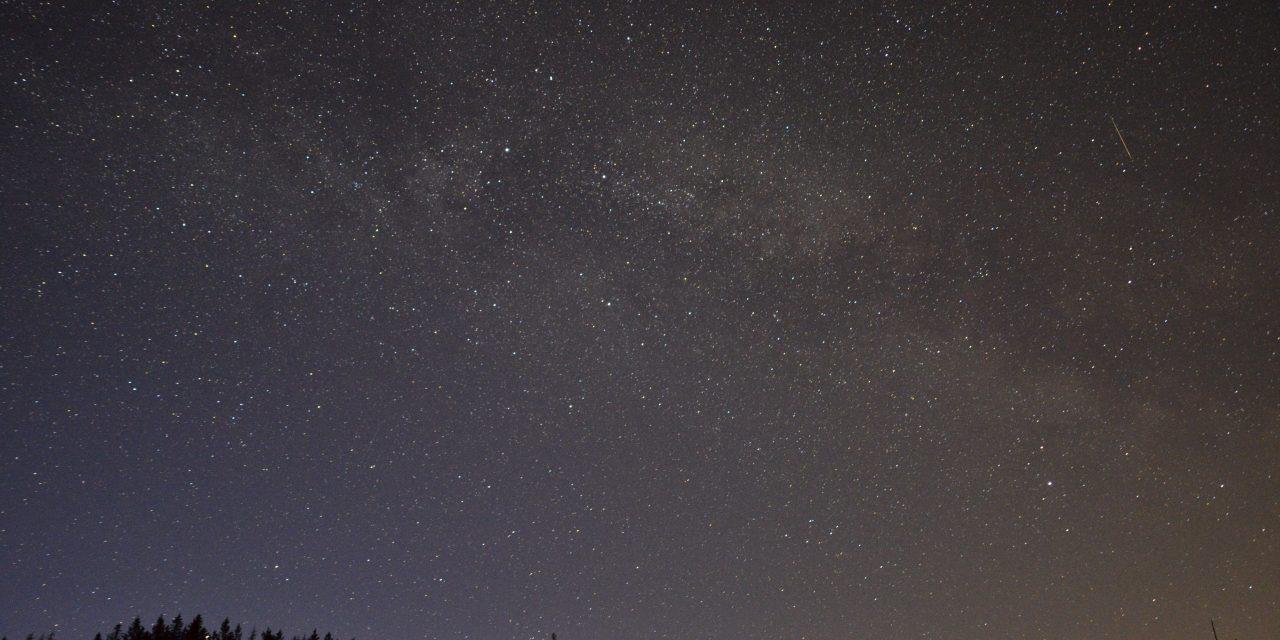
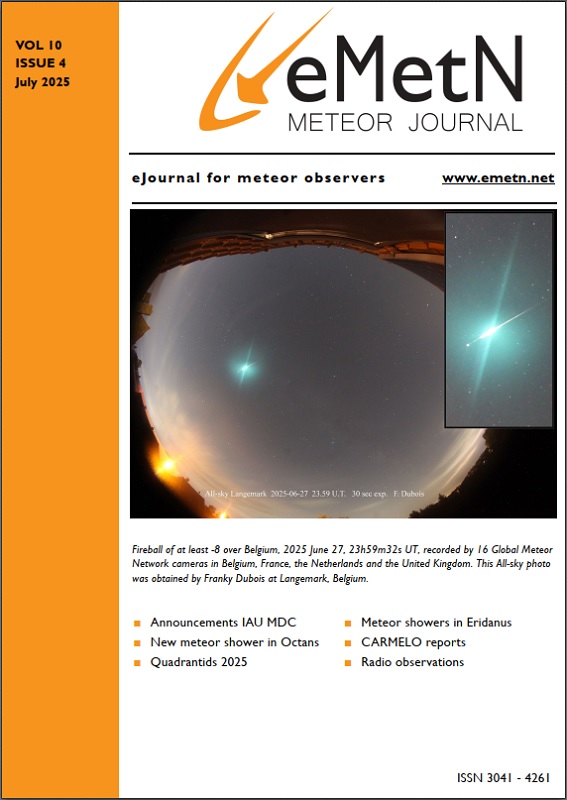
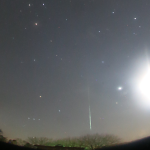
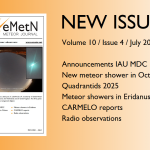
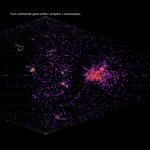
Hi Kai,
thank you for this nice report, I highly enjoyed it.
Any plans for July/August?
Best wishes, Koen
Hi Koen. I do not have any travel plans for July/August this year. Partly because the moon disturbs both the SDA and PER, and partly because of the travel restrictions due to the corona virus. I hope there will be a chance to organize an expedition under the Geminids this year, but i will have to wait and see which destinations that are available.
Best wishes, Kai.